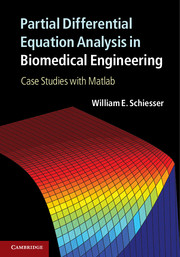Book contents
- Frontmatter
- Contents
- Preface
- 1 Introduction to partial differential equation integration in space and time
- 2 Antibody binding kinetics
- 3 Acid-mediated tumor growth
- 4 Retinal O2 transport
- 5 Hemodialyzer dynamics
- 6 Epidermal wound healing
- 7 Drug distribution from a polymer matrix
- Appendix 1 Origin of convection-diffusion-reaction PDEs
- Appendix 2 Stiffness and eigenvalue analysis of ODE systems
- Index
- References
5 - Hemodialyzer dynamics
Published online by Cambridge University Press: 05 December 2012
- Frontmatter
- Contents
- Preface
- 1 Introduction to partial differential equation integration in space and time
- 2 Antibody binding kinetics
- 3 Acid-mediated tumor growth
- 4 Retinal O2 transport
- 5 Hemodialyzer dynamics
- 6 Epidermal wound healing
- 7 Drug distribution from a polymer matrix
- Appendix 1 Origin of convection-diffusion-reaction PDEs
- Appendix 2 Stiffness and eigenvalue analysis of ODE systems
- Index
- References
Summary
When the kidneys fail to remove sufficient impurities from the blood, a device for removing the impurities is used, which is termed a hemodialyzer or just a dialyzer. Basically it transfers the impurities from the blood to another fluid termed the dialyzate by mass transfer through a membrane. A schematic diagram of a dialyzer is given in Fig. 5.1.
We now consider the derivation of a PDE model based on mass conservation.
1D PDE model
The configuration of a 1D hemodialyzer model is explained in Fig. 5.1, primarily with words.
We can note the following details about the model represented in Fig. 5.1:
• The model is one dimensional (1D) with distance along the dialyzer, z, as the spatial (boundary value) independent variable. Time t is an initial value independent variable.
• Two PDE-dependent variables, u1(z, t),u2(z, t), represent the impurity concentrations in the blood and dialyzate, respectively.The PDEs that define these dependent variables are derived subsequently.
• Blood enters the left end at concentration u1L(t). This BC is not designated as u1(z = 0, t) because of a header volume at the left end (explained next).
• Similarly, the exiting blood concentration at the right end is designated as u1R(t) rather than u1(z = zL, t) (again, because of a header volume).
• The entering and exiting dialyzate concentrations are u2 (z = zL, t) and u2 (z = 0, t), respectively.
[…]
- Type
- Chapter
- Information
- Partial Differential Equation Analysis in Biomedical EngineeringCase Studies with Matlab, pp. 284 - 307Publisher: Cambridge University PressPrint publication year: 2012



